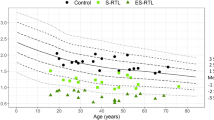Abstract
We explored the association of fecal bacterial species and somatic telomere changes in patients with chronic disease. The results showed that the length of the combined range of telomere and the methylated subtelomere was correlated with the increase of bacteria species and the numerical superiority of certain strains in feces, the increase of streptococci in men and women, and the increase of E. coli specifically in women. These results suggest that the aging status reflected by telomere length and/or demethylation of neighboring regions correlate with intestinal conditions which influences the proportion of the intestinal microbial population. Shortened telomere length and subtelomeric demethylation status are thought to represent the degree of aging and the accelerating stage of aging velocity, respectively. Hence, the observed biased microbial status is considered to be associated with advanced stage or acceleration phase of biological aging.


Similar content being viewed by others
References
Blackburn EH (1991) Structure and function of telomeres. Nature (London) 350:569–573. https://doi.org/10.1038/350569a0
Guan JZ, Maeda T, Sugano M, Oyama J, Higuchi Y, Makino N (2007) Change in the telomere length distribution with age in the Japanese population. Mol Cell Biochem 304:253–260. https://doi.org/10.1007/s11010-007-9518-2
Uziel O, Singer JA, Danicek V, Sahar G, Berkov E, Luchansky M, Fraser A, Ram R, Lahav M (2007) Telomere dynamics in arteries and mononuclear cells of diabetic patients: effect of diabetes and of glycemic control. Exp Gerontol 42:971–978. https://doi.org/10.1016/j.exger.2007.07.005
Brouilette S, Singh RK, Thompson JR, Goodall AH, Samani NJ (2003) White cell telomere length and risk of premature myocardial infarction. Arterioscler Thromb Vasc Biol 23:842–846. https://doi.org/10.1161/01.ATV.0000067426.96344.32
Panossian LA, Porter VR, Valenzuela HF, Zhu X, Reback E, Masterman D, Cummings JL, Effros RB (2003) Telomere shortening in T cells correlates with Alzheimer’s disease status. Neurobiol Ageing 24:77–84. https://doi.org/10.1016/s0197-4580(02)00043-x
Guan JZ, Maeda T, Sugano M, Oyama JI, Higuchi Y, Suzuki T, Makino N (2008) A percentage analysis of the telomere length in Parkinson’s disease patients. J Gerontol A 63:467–473. https://doi.org/10.1093/gerona/63.5.467
Valdes AM, Andrew T, Gardner JP, Kimura M, Oelsner E, Cherkas LF, Aviv A, Spector TD (2005) Obesity, cigarette smoking, and telomere length in women. Lancet 366:662–664. https://doi.org/10.1016/S0140-6736(05)66630-5
Epel ES, Blackburn EH, Lin J, Dhabhar FS, Adler NE, Morrow JD, Cawthon RM (2004) Accelerated telomere shortening in response to life stress. Proc Natl Acad Sci USA 101:17312–17315. https://doi.org/10.1073/pnas.0407162101
Maeda T, Oyama J, Higuchi Y, Koyanagi M, Sasaki M, Arima T, Mimori K, Makino N (2011) The correlation between clinical laboratory data and telomeric status of male patients with metabolic disorders and no clinical history of vascular events. Aging Male 14:21–26. https://doi.org/10.3109/13685538.2010.502270
Maeda T, Oyama JI, Sasaki M, Arima T, Makino N (2011) The correlation between the clinical laboratory data and the telomere length in peripheral blood leukocytes of Japanese female patients with hypertension. J Nutr Health Aging 15:240–244. https://doi.org/10.1007/s12603-010-0137-3
Maeda T, Horiuchi T, Makino N (2018) Epigenetic status of subtelomere of peripheral leukocytes corresponds to cardiographic parameters with a sex association. Geriatr Gerontol Int 18:1415–1419. https://doi.org/10.1111/ggi.13472
Maeda T, Horiuchi T, Makino N (2019) Shorter somatic telomere can be an increased risk for hospitalization. Mol Cell Biochem 455(1–2):1–5. https://doi.org/10.1007/s11010-018-3465-y
Cawthon RM, Smith KR, O'Brien E, Sivatchenko A, Kerber RA (2003) Association between telomere length in blood and mortality in people aged 60 years or older. Lancet 361:393–395. https://doi.org/10.1016/S0140-6736(03)12384-7
Maeda T, Guan JZ, Oyama JI, Higuchi Y, Makino N (2009) Age-related changes in subtelomeric methylation in the normal Japanese population. J Gerontol A 64:426–434. https://doi.org/10.1093/gerona/gln057
Maeda T, Oyama J, Higuchi Y, Nishiyama Y, Kudo Y, Yamori T, Nakazono T, Arima T, Mimori K, Makino N (2011) The physical ability of Japanese female elderly with cerebrovascular disease correlates with the telomere length and subtelomeric methylation status in their peripheral blood leukocytes. Gerontology 57:137–143. https://doi.org/10.1159/000314633
Woodmansey EJ (2007) Intestinal bacteria and ageing. J Appl Microbiol 102:1178–1186. https://doi.org/10.1111/j.1365-2672.2007.03400.x
Sender R, Fuchs S, Milo R (2016) Revised estimates for the number of human and bacteria cells in the body. PLoS Biol 14:e1002533. https://doi.org/10.1371/journal.pbio.1002533
Mitsuoka T (1992) Intestinal flora and aging. Nutr Rev 50:438–446. https://doi.org/10.1111/j.1753-4887.1992.tb02499.x
Vieira AT, Castelo PM, Ribeiro DA, Ferreira CM (2017) Influence of oral and gut microbiota in the health of menopausal women. Front Microbiol 8:1884. https://doi.org/10.3389/fmicb.2017.01884
Author information
Authors and Affiliations
Corresponding author
Additional information
Publisher's Note
Springer Nature remains neutral with regard to jurisdictional claims in published maps and institutional affiliations.
Electronic supplementary material
Below is the link to the electronic supplementary material.
Rights and permissions
About this article
Cite this article
Maeda, T., Horiuchi, T. & Makino, N. Chromosomal terminal methylation status is associated with gut microbiotic alterations. Mol Cell Biochem 476, 157–163 (2021). https://doi.org/10.1007/s11010-020-03892-7
Received:
Accepted:
Published:
Issue Date:
DOI: https://doi.org/10.1007/s11010-020-03892-7




